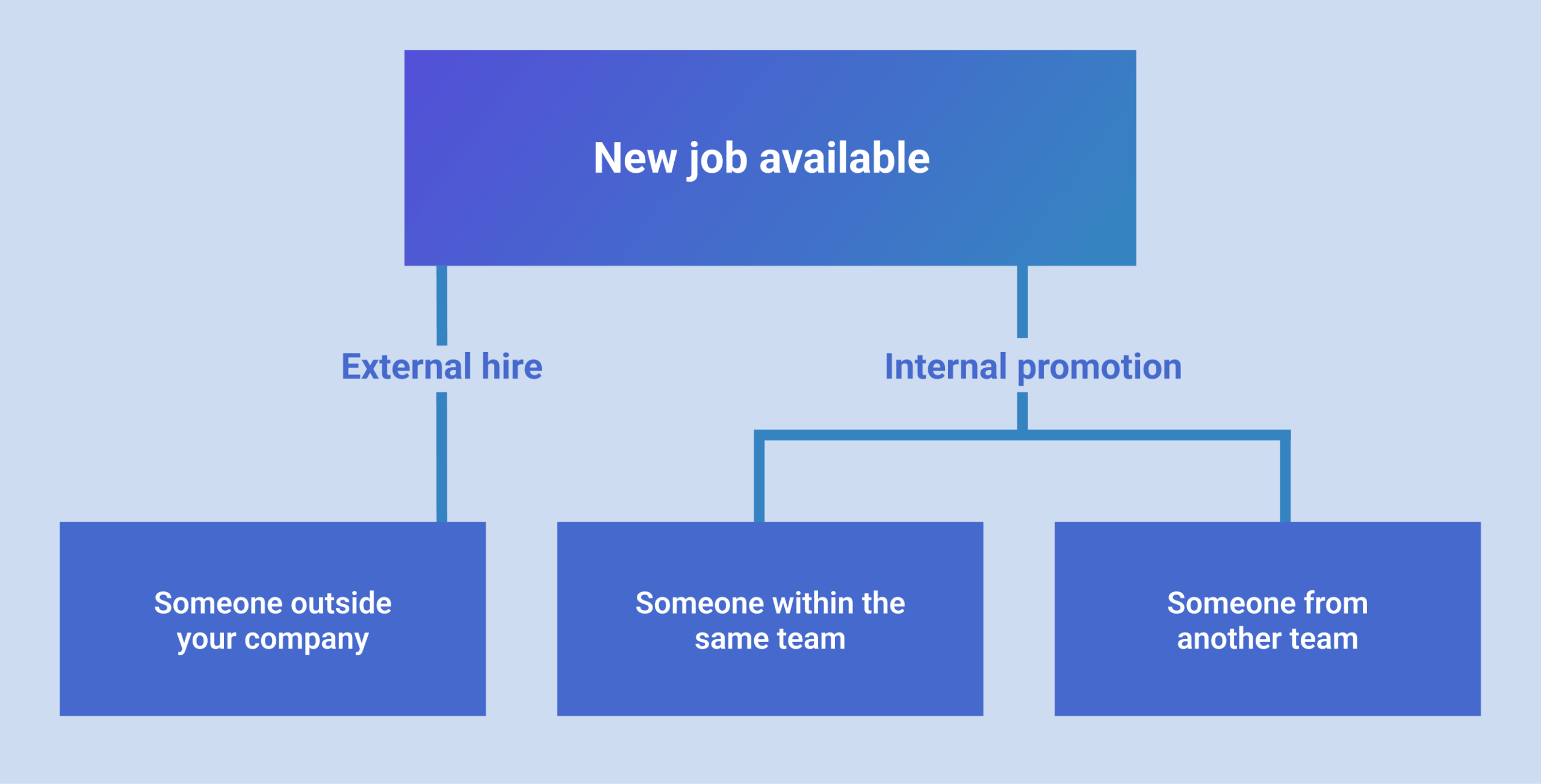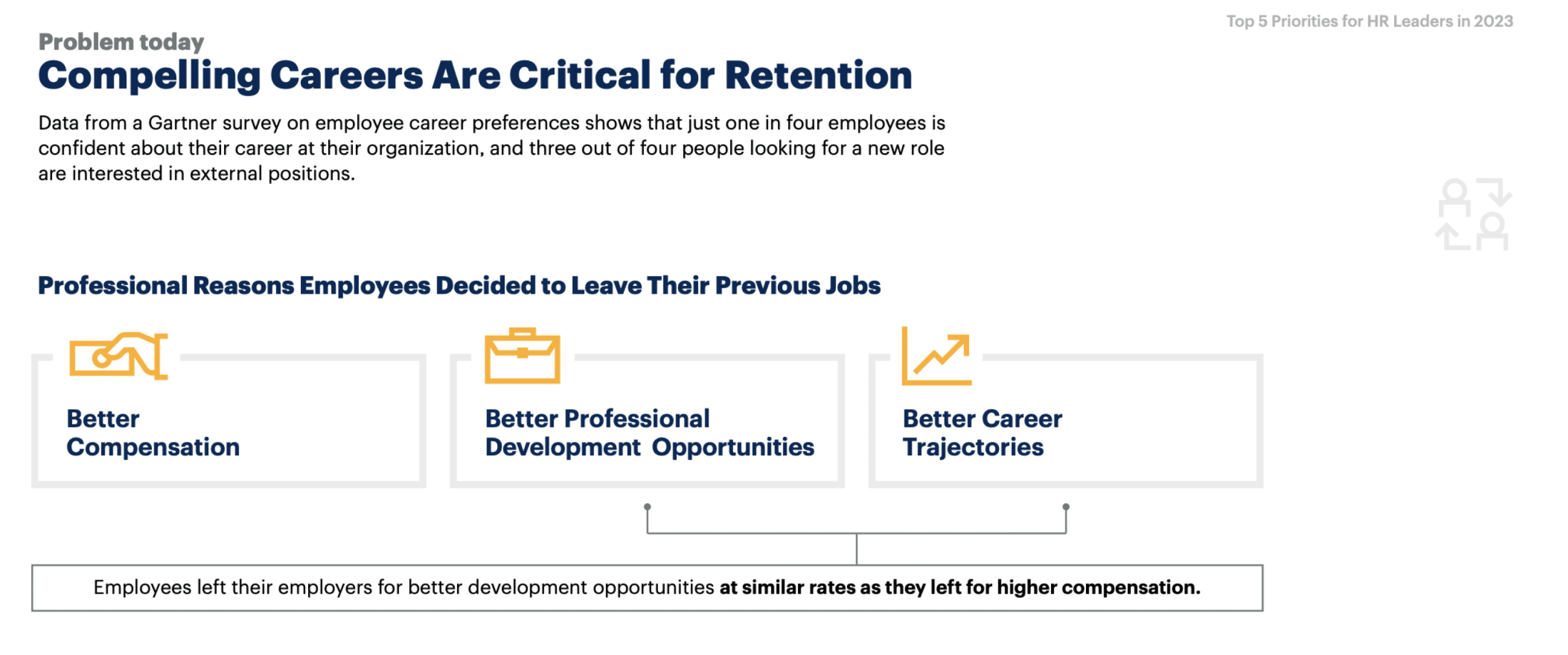A few years ago, one of the managers at my company quit. I was given the daunting task of making the choice — promote from within or make an external hire. So many questions came into my head. I know it’s cheaper to hire internally, but who do I choose? And how do I know they are ready? Am I passing up on a great external candidate?
Internal promotion has a much bigger impact on both employee satisfaction and retention than we realize, you’ll see why later in the article.
The wrong decision would cost me (and the company) a lot.
In this article, I’ll give you everything you need to make the internal vs. external hiring decision and I’ll include the tips I wish I had when I was making my choice.
We’ll cover:
- What does “promoting from within” actually mean
- A breakdown of the pros and cons of promoting internally
- How you can use internal promotion and mobility to cut turnover by 75%
- 8 tips to run a successful internal promotion process
What Is Internal Promotion?
Internal promotion happens when you choose to promote someone within the company, rather than hire someone new. The employee can be promoted from the same team or the company will choose to promote someone with cross-functional skills from another department.

You might decide to use internal promotion when you need to replace someone that leaves the company or when the company is growing and a need for a new managerial position arises.
Whether or not a company decides to promote someone from within usually depends on the skill level and leadership ability of its existing employees.
Your next question is probably “why should you choose someone internal instead of hiring someone external?”
We’re huge fans of the old pro/con list, so let’s break it down.
Pros and Cons of Promoting from Within
Pros of promoting from within
1. Reduced recruitment time (and cost)
Even though internal candidates should go through a nearly identical recruitment process, there is one key difference: sorting through non-relevant applications.
Any recruiter knows that at least half of the applications aren’t relevant to fill the job you’re looking for. But when you’re open to promoting from within, you can control this.
If you have the right documentation, your HR team can easily define who would be a relevant fit.
2. Faster onboarding
When you promote internally, the candidate will have already gone through all of the basic company training at the least. At the most, they will have been on the same team and will have nearly all the info they need to start.
They will still need a bit of training, but they’ll become operational much faster than external hires.
3. High employee retention
It’s simple — if employees know there is a possibility for them to grow within a company, they are much more likely to stay.
A Gartner study identified that only one in four employees is confident about their career at their organization, and three in four are open to external opportunities.

That means if you can provide internal promotion and mobility for employees, you could cut turnover by up to 75%.
But more on how to do that later.
4. Increased employee development
Internal promotion is synonymous with never-ending challenges and personal development for high performers.
Which basically guarantees you’ll end up with an all-star team.
Why? Because you already hired someone performing well enough to be considered for a promotion. By promoting them you’re helping them acquire new skills, making them an even more qualified employee.
How to apply this: Many companies offer graduate programs after internships for this reason. They identify a group of interns with high development potential and train them to become future managers.
5. Better cultural fit
We’re in the 21st century… people no longer make their job decisions solely on salary and traditional benefits.
Half the battle of joining a new company is fitting in with the work style, values, and overall vibe.
By promoting internally you can ensure the new manager not only fits in but also exemplifies the culture you want to exude.
6. Less risk
All in all, promoting from within is less of a risk. You won’t end up hiring someone that secretly has no idea how to use excel but faked their way through the entire hiring process.
You know the internal hire will fit in with the company and has succeeded in their current role. Plus you can confirm their skills with current managers.
But the key to this is going about promoting from within the right way.
For example, if you promote someone that doesn’t already exemplify the skills needed, you might end up with an employee that’s not performing well. And in this case it’s much harder to deal with a bad promotion than a bad hire.
I’ll give some tips later to ensure this doesn’t happen to you.
Now you know all the reasons why you should promote from within, but what about the reasons why it might not work out?
Cons of promoting from within
1. Groupthink
This basically means there’s no devil’s advocate.
Groupthink is a psychological phenomenon that happens when a group of people continuously make decisions without challenging them.
And this leads to less strategic and more comfortable decisions, which could seriously impact the company revenue in the long run. Especially in smaller companies that are trying to grow. Making comfortable decisions over and over won’t get you the crazy growth you’re looking for — it’ll do the opposite.
It’s a risk if you constantly promote people from the same team that have similar ideas and reasoning as their predecessors.
2. Lack of diversity
In short, diversifying your employees can combat groupthink and make your company more inclusive.
But internal promotion could go against this if this wasn’t top of mind when the company hired its previous employees.
Make sure to consider this when thinking about internal promotion.
Determine if you’re (unintentionally) promoting one type of person, or leaving growth opportunities open to everyone.
3. Internal conflict (aka gossip and fighting)
In some cases, you won’t be able to clearly identify one top performer that should be promoted and you’ll need to interview several current employees…
Take it from me, this can cause a lot of internal drama.
It starts when people find out who applied for the promotion. Then the candidates are pitted against each other but still have to work together. Their co-workers are often asked about their experience working with that person, causing more tension between those employees. Then when you do find the right candidate to promote, the other will often feel a lack of support from management and their existing team, and they might decide to leave the company.
It’s too much conflict. But this is just a possibility and one that is preventable based on how you handle the promotion process.
The keys to avoiding this are in the next section.
4. Passing by a more qualified candidate
If you promote from within simply because it’s easy and more cost-effective, you’ll often become a victim of this.
You can get into some real trouble if you promote an employee that:
- Isn’t ready for a leadership position.
- Doesn’t have the experience necessary for this job.
- Isn’t easily trainable.
If you promote someone in any of these situations it’ll end up costing you more.
The problem is you’ll eventually have to let them go and find two new hires to replace the position you were trying to fill and the person you prematurely promoted.
Honestly, if you should or should not promote from within will mostly depend on the candidates available within your company + how you handle the situation.
Because all in all — the pros usually outweigh the cons when it comes to internal promotion.
We’ll dig into how to avoid these ‘cons’ and how you can set your company up for successful internal promotions in a minute.
How to Decrease Turnover with Internal Promotion and Mobility
Promoting from within doesn’t only cover filling a leadership role with someone lower in the company hierarchy.
It also means you allow employees to move horizontally in an organization, oftentimes called internal mobility.
Use internal mobility to your advantage
With internal mobility, you are open to people changing roles in your company without increasing their seniority. And doing this significantly decreases employee turnover, especially among younger employees.
A recent tenure study by the US Department of Labor reported: “the median tenure of workers ages 55 to 64 (9.8 years) was more than three times that of workers ages 25 to 34 years (2.8 years)”.
But internal mobility can definitely improve the numbers for the 25-34 age range.
How? If you can show your employees that they can change job roles (meaning new responsibilities, teams, and managers), it provides them with the new experience they are craving.
For example, someone working as a Communications Project Manager for Fragrances at L’Oréal could move to a position as a Corporate Communications Manager. Similar skills are needed for both of these roles but the projects are entirely different (and may even involve changing physical locations).
But to run this transition successfully you’ll need to adopt a few essential internal promotion and mobility practices.
8 tips for successfully promoting from within
These tips will help your company avoid the ‘cons’ mentioned above and execute a stellar internal promotion process.
1. Keep the application process the same for internal vs. external employees
On the candidate experience side, the internal candidate should have a nearly identical experience compared to anyone applying externally.
They should undergo the same application scanning, skill tests, cultural fit interviews, and reference checks that anyone else would.
This will not only decrease any unconscious biases you or your company may have, but will also significantly decrease the cons of internal promotion.
It eliminates the possibility of you hiring someone that’s not ready for a promotion and limits the amount of gossip that would happen if you change the hiring process.
2. Give necessary training to candidates that were promoted from within
Too many companies assume if they hired someone internally they already know everything they need to succeed in their new role. Spoiler: they don’t.
It’s natural to forget what they are missing because they were clearly qualified enough for the position. But to make sure they succeed in their new position, you need to give them the training they didn’t get in their previous role.
For example, if you promoted a Junior Content Manager to a Content Team Lead, you would offer leadership training. Or if you made a horizontal promotion to someone from Director of Marketing to Head of People, they would need some training on how your HR team works and any specialized training like diversity and inclusion.
Bottom line here: make sure they aren’t missing any of the info they would have gotten if they had started this role in another company.
3. Use internal performance tracking and evaluations
First, make sure you’re conducting regular employee evaluations to know which employees are overperforming and might be interested in a promotion.
Second, keep track of their current skills improvement and the ones they want to start training for. This gives you a better idea of who may be able to move horizontally.
Both of these can be updated during the skills assessment part of quarterly and yearly employee evaluations!
Just make sure it’s documented and available to the HR team.
4. Start regular temperature checks with managers
This is basically just a check-in from employee to manager to determine how the employee is liking their current job.
It should be a chance to have a completely open chat about where they want their career to go and how the company can help them with this.
This is also something that should be done during regular evaluations. Quarterly is the best for ensuring positive employee experiences, yearly at the minimum.
5. Reinforce an open-door HR policy
It’s best to automatically assume that not all managers are going to be supportive of internal promotion and mobility — the HR team should be ready to pick up the slack.
In this case, that means allowing employees to openly express when their managers aren’t being supportive, and immediately take action to correct it. And if an employee does bring this up, it’s probably time for them to make a horizontal move.
Otherwise you’ll end up with a situation where the employee feels forced to stay in their current role and starts resenting their manager (and later on the company). Eventually, they might quit.
Preventing this will decrease employee turnover and keep your development culture strong!
6. Incentivize managers who allow for mobility
Building on previous points, you can incentivize managers to allow their employees to move around.
This ensures managers aren’t holding their employees back for selfish reasons.
An example I’ve seen is a company that used an internal mobility incentive program similar to a referral program, offering a bonus to managers based on their employee’s future performance in their new role.
7. Provide interview training to all employees
This is the best tip for fighting that ugly Gartner stat about one in four employees not feeling confident in their career at an organization.
If you aren’t actively showing your employees you care about their career growth, they are going to start looking externally.
Instead, give them training resources they can access at any time to improve their interview skills. Your employees will be 100% sure that you are preparing them for internal job opportunities.
The best way to do this is with industry and competency-based training. This will help them improve in their current position and prep them for any internal promotion or mobility interviews you throw their way.

8. Offer long-term employee benefits
One last thing you should be doing to encourage internal promotion and mobility (and therefore increase retention) is to offer benefits based on employee tenure.
Hilton is a great example of this. They offer employees who stay for 20+ years access to team member rates for the rest of their lives. Meaning they can stay at the nicest hotels in the world for a max of $75/night. And if employees stay 10+ years, they get access to friends and family rates for the rest of their lives (35-50% off the standard room rate).
Benefits like this would make any employee think twice before looking externally.
Key Takeaways
In the end, I decided to fill my management position from within.
I opened the position to external candidates, interviewed both internally and externally, and decided to promote one employee and make a horizontal shift for another. Both employees are still there to this day.
We can clearly see that internal promotion and mobility is great for increasing employee experience and decreasing turnover.
But let’s keep in mind some of the essential points that make it possible:
- Internal promotion and mobility shouldn’t be used all the time — you’ll end up limiting company diversity and passing up on great candidates.
- It needs to be bottom-up and top-down — managers need to support their employees moving and employees need to be open with managers.
- An internal promotion and mobility process needs to be put in place — employees should get regular training to ensure they will make it to the next level in their career, and get any missing training once they are promoted.
Now you have everything you need to start hiring from within. And you can always come back to this article if you’re struggling once you begin the process.
______________________________________________
Need a hand? There are 2 ways we can help you:
